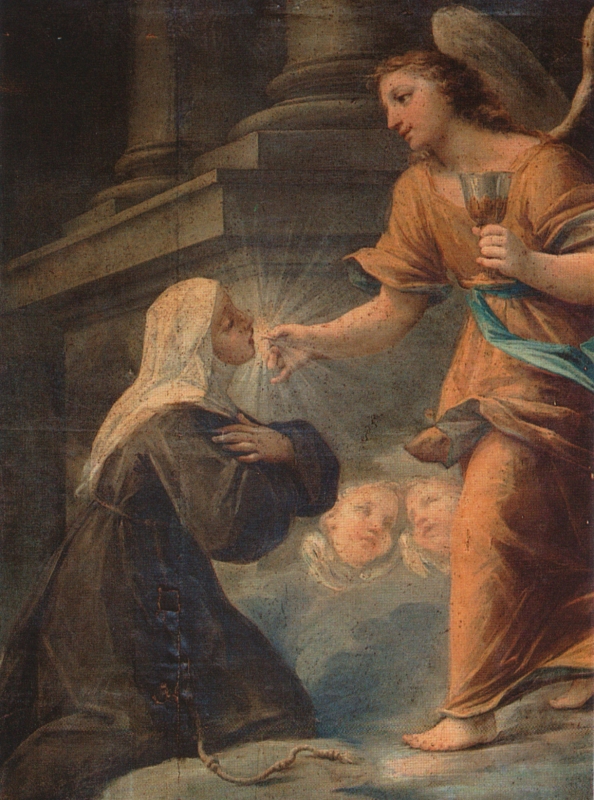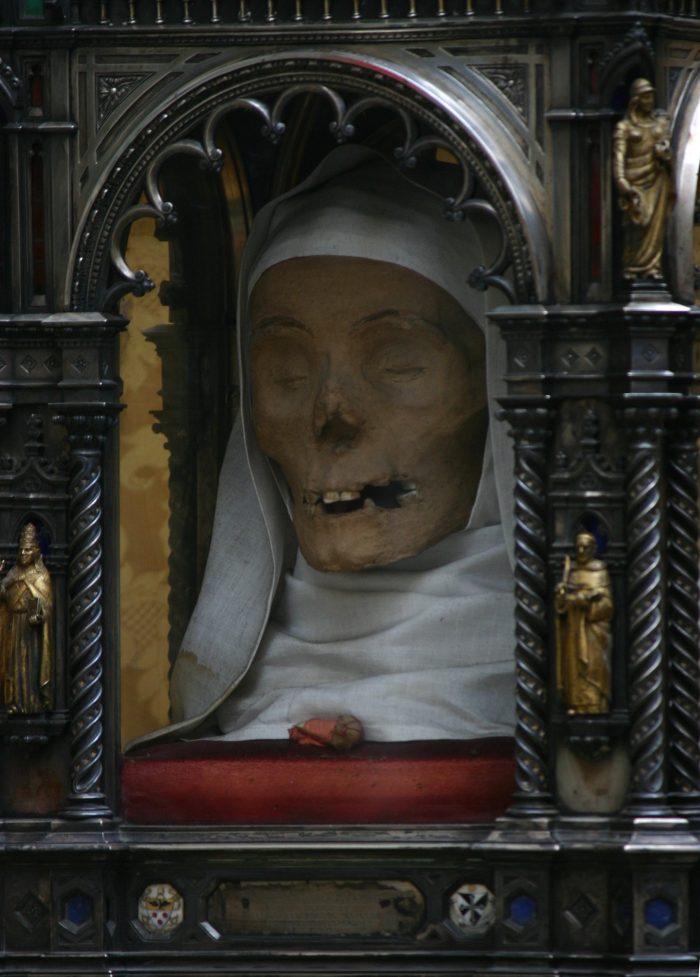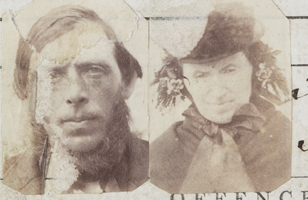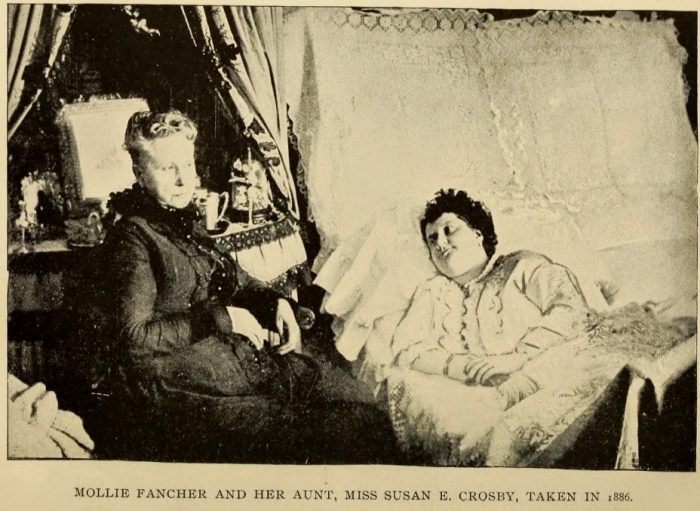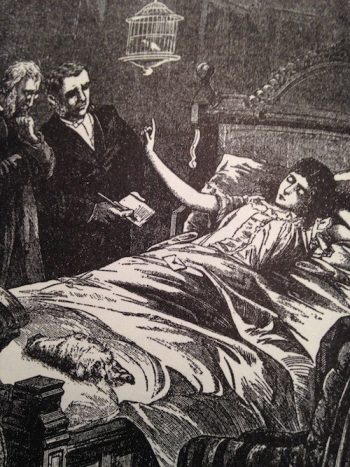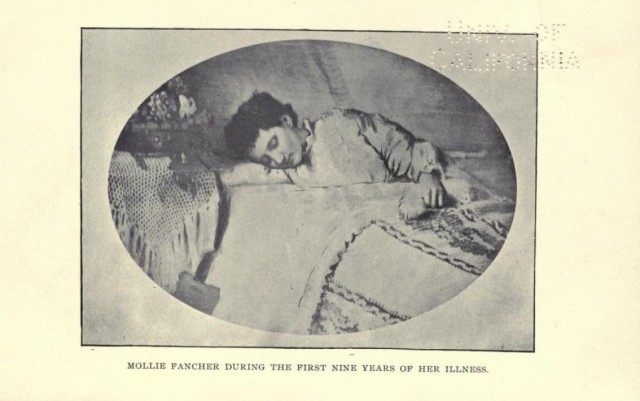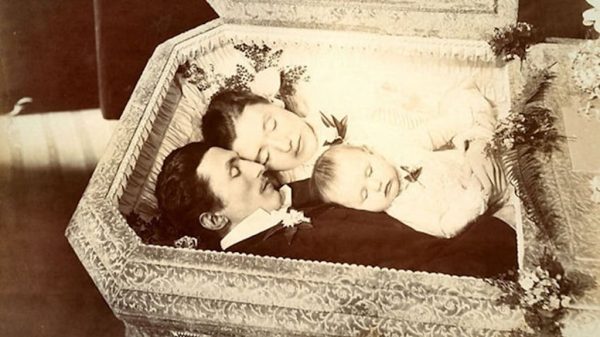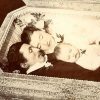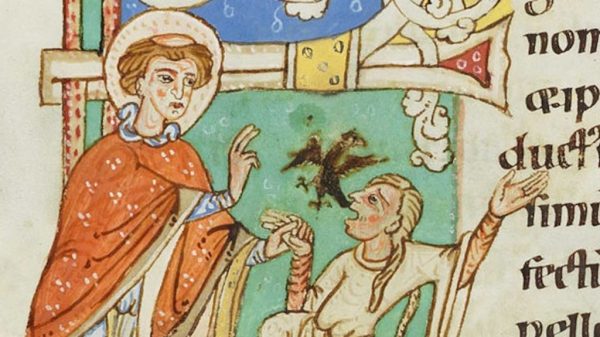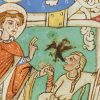Women have long been associated with food, whether it’s as providers and preparers in the domestic setting, or as a sexual feast to be consumed. Our relationship with food is complex, and every woman I know has at some point in her life been questioned by herself and others about what she is eating – is it too much, too little, too fatty, too sugary, too healthy? In 2016, we have #ana and #thinspiration exploding across social media, fuelled by decades, even centuries, of cultural criticism of women’s weight. But while today’s anorexia nervosa is an individualistic pursuit, in the Middle Ages across Catholic Europe, young women “suffering” from anorexia mirabilis – miraculous lack of appetite – were seen as ascetics and saints. These women – saints like Angela of Foligno (1248-1309) and Catherine of Siena (1347-1380) – were upheld by their communities as pillars of the religious community, women who took their holy fasting to a new level of discipline and devotion to God. This carried forward to the Victorian era, where “fasting girls” captured the admiration and attention of the public because of their miraculous ability to live without food.
Fasting in the 13th to 16th centuries was seen as a way to purge oneself of sin and to bring the human body closer to God. Denying food to their bodies made them more pure in the eyes of God and their peers, leaving no doubt about their intact virginity and pious mind. By refusing to eat anything but the holy Eucharist for extended periods of time – weeks, and often months – women would gain an unsurpassed level of spiritual awakening and purity, as well as the respect and admiration of their community. These women were purported to gain special powers akin to that of Jesus; healing the sick with their touch and saliva, the ability to miraculously multiply food and drink, as well as other, stranger, benefits like virginal lactation and producing oil from their fingertips. Angela of Foligno went much further than only dining on the holy Eucharist – in attending to the sick, she also ate their scabs and lice, and drank pus from their wounds, calling it “sweet.” No wonder she didn’t have an appetite. While Angela died in her sleep at the healthy age of 61, Catherine of Siena died of starvation at age 33, after suffering a stroke the week before and having lost the use of her legs months earlier. However, both women were canonized – Catherine in 1461 and Angela just three years ago in 2013 – recognizing their cult status in the Catholic faith. For both, their ability to deny themselves nourishment was at the root of their sanctification.
Fast forward a century or two, and the Reformation declared that extreme fasting and anorexia mirabilis were not only deviant activities for women in the faith to pursue, but they were also associated with Satan and not God. Women were no longer celebrated for their ability to refuse food in God’s name, they were considered sick and to be suffering from a debilitating condition. Today, we call it anorexia nervosa. But in the Victorian period there was a resurgence in the belief in miraculous fasting, with the public sensations of the Fasting Girls. There were several instances of young women refusing to eat for weeks and allegedly even years at a time, and they became media sensations in the US and Europe. They were studied by doctors and monitored day and night by nurses; they were front page news for an astonished public who were obsessed with their ability to survive on nothing at all, or tiny amounts of specific foods like fruits or beef tea. The term “fasting girl” was applied by the medical community, and used interchangeably with anorexia mirabilis, denoting a miraculous quality to their emaciation.
Sarah Jacob, known as the “Welsh fasting girl,” was only 12 years old when she died of starvation. According to her parents, she stopped eating at the age of 10, and after their local vicar cosigned the authenticity of her case, she became famous worldwide. People would make pilgrimage to her farmhouse, bringing her gifts and money, believing her to be in holy communion with God. Despite the fact that she was raised Protestant, she was surrounded with Catholic imagery in order to reinforce her connection with the miraculous fasting performed by saints like Catherine and Angela centuries earlier. Her parents were largely ignored by the media, other than believing them to be honest and trustworthy when it came to their daughter’s behaviour. The media documented her slow emaciation, watching her body mortify and decay before the world’s eyes. Doctors were highly skeptical of the case, and eventually Jacob’s family agreed to put her under 24 hour surveillance by four nurses from Guy’s Hospital in London. The nurses were told by her parents that if they offered her food, her condition would worsen, resulting in “fits,” so they should under no circumstances encourage her to eat. Sarah refused to ask for food, so the nurses watched her deteriorate over the course of ten excruciating days, at the end of which she died of starvation. Although during the period of observation doctors were pressuring her parents to hospitalize her, they insisted that God was watching over her and would take care of her. After her death, her parents were found guilty of manslaughter and sentenced to hard labor. The medical profession believed that her fasting was caused by hysteria and a religious addiction, and that the public attention only fuelled her mental illness.
The UK had their fair share of “fasting girls” in the 1800s, but so did the US. Mollie Fancher, the “Brooklyn Enigma,” was the best known of the 19th century. Her case involved not only fasting, but clairvoyance and multiple personality disorder. At the age of 19, she was diagnosed with nervous indigestion after refusing to eat for several weeks. As a treatment, her doctor prescribed horseback riding, leading to an accident where she was thrown from her horse, resulting in a head injury and several broken ribs. She recovered and was seemingly healthy again, when a year later she was knocked over and dragged by a coach for a full city block. Again Mollie suffered from broken ribs and head trauma, but this time she didn’t return to good health. Instead, she lay bedridden for the next fifty one years. She was diagnosed with hysteria – as usual – and suffered from vision problems and fainting spells. She would fall into trances, and claimed to have the ability to read minds and give prophesies. For the first nine years, she lay in bed with only one usable arm and little to no vision, but she produced a huge quantity of written letters, embroidery and wax flowers, all of which added to her notoriety. The combination of her status as a fasting girl who claimed to have lived without food for seven weeks at a time, and her appeal in the spiritualism world, meant that she gained fame around the world.
After nine years of clairvoyance and fasting and one month of unconsciousness, Mollie “woke up” with no memory of the past decade. She claimed that her actions were those of someone else, “Madame X,” and she developed several new personalities, “Sunbeam” being her primary. When she was visited, “Sunbeam” would try and recreate the acts of “Madam X” for them, but she also had four other personalities that developed in later years. At night, after 11pm, Sunbeam would be replaced by one of her other personalities: “Idol,” who actively tried to sabotage Sunbeam by ruining any embroidery she had done that day; “Rosebud,” who was a seven-year-old girl; “Pearl,” who was about 17 or 18; and “Ruby,” a more vivacious version of “Sunbeam” Mollie. Although she was one of the very few cases of multiple personality disorder in history, she was not extensively studied because of the medical profession’s skepticism about her claims of clairvoyance and miraculous fasting. However, she captured the attention of the public, who were fascinated with her perfect combination of religious asceticism, feminine frailty and Victorian spiritualism.
There have been many cases of both medieval anorexia mirabilis and Victorian “fasting girls,” and the common thread is the public excitement and admiration they received for their actions. Their malnourishment was fetishized to the point of canonization and celebrity status, and their refusal of food was seen as the ultimate feminine act. It’s not a simple line to draw, but today you can still see that women who deny themselves food or control their desire to eat are held in a high regard by our culture. Well, I like to eat, so fuck that.
Sources:
Fasting Girls: The History of Anorexia Nervosa, Joan Jacobs Brumberg
http://www.oddlyhistorical.com/2014/09/22/mollie-fancher-the-brooklyn-enigma/


